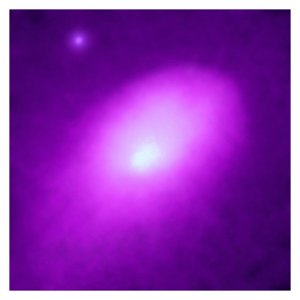| Topic: Is gravity altered by an unknown force? | |
|---|---|
|
Edited by
mightymoe
on
Thu 01/28/16 10:45 AM
|
|

A fifth force may exist that disrupts the predictions general relativity makes outside our own galaxy, on cosmic-length scales. University of Pennsylvania astrophysicist, Bhuvnesh Jain, says the nature of gravity is the question of a lifetime. As scientists have been able to see farther and deeper into the universe, the laws of gravity have been revealed to be under the influence of an unexplained force. Two branches of theories have sprung up, each trying to fill its gaps in a different way. One branch — dark energy — suggests that the vacuum of space has an energy associated with it and that energy causes the observed acceleration. The other falls under the umbrella of "scalar-tensor" gravity theories, which effectively posits a fifth force (beyond gravity, electromagnetism and the strong and weak nuclear forces) that alters gravity on cosmologically large scales. "These two possibilities are both radical in their own way," Jain said. "One is saying that general relativity is correct, but we have this strange new form of energy. The other is saying we don't have a new form of energy, but gravity is not described by general relativity everywhere." Jain's research is focused on the latter possibility; he is attempting to characterize the properties of this fifth force that disrupts the predictions general relativity makes outside our own galaxy, on cosmic length scales. By analyzing a well-studied class of stars in nearby galaxies, Jain and his colleagues have produced new findings that narrow down the possibilities of what this force could be. Their findings are a vindication of Einstein's theory of gravity. Having survived a century of tests in the solar system, it has passed this new test in galaxies beyond our own as well.In 1998, astrophysicists made an observation that turned gravity on its ear: the universe's rate of expansion is speeding up. If gravity acts the same everywhere, stars and galaxies propelled outward by the Big Bang should continuously slow down, like objects thrown from an explosion do here on Earth. This observation used distant supernovae to show that the expansion of the universe was speeding up rather than slowing down. This indicated that something was missing from physicists' understanding of how the universe responds to gravity, which is described by Einstein's theory of general relativity. Jain's breakthrough came about when he and his colleagues realized they could use the troves of data on a special property of a common type of star as an exquisite test of gravity. Astrophysicists have been pursuing tests of gravity in the cosmos for many years, but conventional tests require data on millions of galaxies. Future observations are expected to provide such enormous datasets in the coming data. But Jain and his colleagues were able to bypass the conventional approach. "We've been able to perform a powerful test using just 25 nearby galaxies that is more than a hundred times more stringent than standard cosmological tests," Jain said.The nearby galaxies are important because they contain stars called cepheids that are bright enough to be seen individually. Moreover, cepheids have been used for decades as a kind of interstellar yardstick because their brightness oscillates in a precise and predictable way. In the image below, the circled star is the Cepheid variable star V1, discovered by Edwin Hubble in 1923. The brightness of a Cepheid variable star oscillates with a very regular period, and because the star's luminosity is directly related to its oscillating period, the distance to the star can be determined fairly accurately. When Hubble calculated the distance to V1, he realised it was too far away for it to be part of our own Milky Way galaxy. Astronomers had been debating the size of the universe around this time, and Hubble's discovery proved that the Andromeda Galaxy is a large independent galaxy, not a small nebula within our own galaxy. 
© Chandra X-ray Observatory "You can measure the brightness of a light bulb at some distance and know that, if you move it twice as far, it will be four times as faint. So you can tell just by the difference in its observed brightness how much further you moved it," Jain said. "But you need to know how intrinsically bright the bulb is first to determine its actual distance from us." Cepheids have a unique trait that allows astrophysicists to get this critical information: their luminosity oscillates over the course of days and weeks. The known relationship between a cepheid's rate of oscillation and intrinsic brightness serves as that baseline for calculating its distance from Earth, which in turn serves as a baseline for calculating the distance of other celestial objects. The accelerating universe observation, for example, relied upon cepheid data for scale. "Now that we understand a little bit more about what makes the cepheids pulsate — a balance of gravity and pressure — we can use them to learn about gravity, not just distance," Jain said. "If the fifth force enhances gravity even a little bit, it will make them pulsate faster." Because of their usefulness, there was already more than a decade of data on cepheids based on the Hubble Space Telescope and other large telescopes in Chile and Hawaii. Using that data, Jain and his colleagues compared nearly a thousand stars in 25 galaxies. This allowed them to make comparisons between galaxies that are theoretically "screened" or protected from the effects of the hypothetical fifth force and those that are not. Larger galaxies and ones that belong to galaxy clusters are screened, while smaller, isolated galaxies are not. "If we compare galaxies that don't permit this extra force, like our own galaxy, with others that do, then we should see a difference in the way those galaxies' cepheids behave," Jain said. "Because this new force would increase the speed of their oscillations and because we can use the rate of their oscillations to their measure distance from us, the measurement we get from cepheids in unscreened galaxies should be smaller than distance measurements made with different techniques." Jain and his colleagues ultimately did not see variation between their control sample of screened galaxies and their test sample of unscreened ones. Their results line up exactly with the prediction of Einstein's general relativity. This means that the potential range and strength of the fifth force is severely constrained. "We find consistency with Einstein's theory of gravity and we sharply narrow the space available to these other theories. Many of these theories are now ruled out by the data," Jain said.With better data on nearby galaxies in the coming years, Jain expects that an entire class of gravity theories could essentially be eliminated. But there remains the exciting possibility that better data may reveal small deviations from Einstein's gravity, one of the most famous scientific theories of all time. In the image at the top of the page, the bright source in the upper left is an active galaxy in the cluster, Abell 2142,six million light years across that contains hundreds of galaxies and enough gas to make a thousand more. It is one of the most massive objects in the universe. The Daily Galaxy via Pennsylvania State University http://www.dailygalaxy.com/my_weblog/2016/01/gravity-may-be-altered-by-an-unknown-fifth-force-todays-galaxy-insight.html |
|
|
|
|
|
That's 20 paras of reading.
So does the fifth force exists or not? |
|
|
|
|
|
That's 20 paras of reading. So does the fifth force exists or not? make some calculations and find out...but like everything else in astrophysics, just a theory... |
|
|
|
|
|
That's 20 paras of reading. So does the fifth force exists or not? make some calculations and find out...but like everything else in astrophysics, just a theory... where T is the period of oscillating luminosity L, the distance from earth and 'g' varying with distance from Great Attractor --xx-- since the target star 'cepheid' is not oscillating faster, i.e, T is constant, i.e., the ratio L/g a constant even as the stars / galaxy move further away - no fifth force exists. --xx-- And Jain is getting paid by Pennsylvania State University to prove that a fifth force does not exist? what a scam!! |
|
|
|
|
|
That's 20 paras of reading. So does the fifth force exists or not? make some calculations and find out...but like everything else in astrophysics, just a theory... where T is the period of oscillating luminosity L, the distance from earth and 'g' varying with distance from Great Attractor --xx-- since the target star 'cepheid' is not oscillating faster, i.e, T is constant, i.e., the ratio L/g a constant even as the stars / galaxy move further away - no fifth force exists. --xx-- And Jain is getting paid by Pennsylvania State University to prove that a fifth force does not exist? what a scam!! read the last four paragraphs... |
|
|
|
|
|
That's 20 paras of reading. So does the fifth force exists or not? make some calculations and find out...but like everything else in astrophysics, just a theory... where T is the period of oscillating luminosity L, the distance from earth and 'g' varying with distance from Great Attractor --xx-- since the target star 'cepheid' is not oscillating faster, i.e, T is constant, i.e., the ratio L/g a constant even as the stars / galaxy move further away - no fifth force exists. --xx-- And Jain is getting paid by Pennsylvania State University to prove that a fifth force does not exist? what a scam!! read the last four paragraphs... alright, here we go.. Para 17 " Jain and his colleagues ultimately did not see variation between their control sample of screened galaxies and their test sample of unscreened ones. Their results line up exactly with the prediction of Einstein's general relativity. This means that the potential range and strength of the fifth force is severely constrained."
Huh! No fifth force? After 16 paras of hope - no fifth force Para 18 "We find consistency with Einstein's theory of gravity and we sharply narrow the space available to these other theories. Many of these theories are now ruled out by the data," Jain said.With better data on nearby galaxies in the coming years, Jain expects that an entire class of gravity theories could essentially be eliminated. But there remains the exciting possibility that better data may reveal small deviations from Einstein's gravity, one of the most famous scientific theories of all time."
No fifth force. Jain predicts |entire class of Gravity theories will be eliminated Sounds like 'zero sum' Para 19 In the image at the top of the page, the bright source in the upper left is an active galaxy in the cluster, Abell 2142,six million light years across that contains hundreds of galaxies and enough gas to make a thousand more. It is one of the most massive objects in the universe. So what has Abell got to do with all this? Commercial break? Para 20 The Daily Galaxy via Pennsylvania State University http://www.dailygalaxy.com/my_weblog/2016/01/gravity-may-be-altered-by-an-unknown-fifth-force-todays-galaxy-insight.html |
|
|
|
|
|
That's 20 paras of reading. So does the fifth force exists or not? make some calculations and find out...but like everything else in astrophysics, just a theory... where T is the period of oscillating luminosity L, the distance from earth and 'g' varying with distance from Great Attractor --xx-- since the target star 'cepheid' is not oscillating faster, i.e, T is constant, i.e., the ratio L/g a constant even as the stars / galaxy move further away - no fifth force exists. --xx-- And Jain is getting paid by Pennsylvania State University to prove that a fifth force does not exist? what a scam!! read the last four paragraphs... alright, here we go.. Para 17 " Jain and his colleagues ultimately did not see variation between their control sample of screened galaxies and their test sample of unscreened ones. Their results line up exactly with the prediction of Einstein's general relativity. This means that the potential range and strength of the fifth force is severely constrained."
Huh! No fifth force? After 16 paras of hope - no fifth force Para 18 "We find consistency with Einstein's theory of gravity and we sharply narrow the space available to these other theories. Many of these theories are now ruled out by the data," Jain said.With better data on nearby galaxies in the coming years, Jain expects that an entire class of gravity theories could essentially be eliminated. But there remains the exciting possibility that better data may reveal small deviations from Einstein's gravity, one of the most famous scientific theories of all time."
No fifth force. Jain predicts |entire class of Gravity theories will be eliminated Sounds like 'zero sum' Para 19 In the image at the top of the page, the bright source in the upper left is an active galaxy in the cluster, Abell 2142,six million light years across that contains hundreds of galaxies and enough gas to make a thousand more. It is one of the most massive objects in the universe. So what has Abell got to do with all this? Commercial break? Para 20 The Daily Galaxy via Pennsylvania State University http://www.dailygalaxy.com/my_weblog/2016/01/gravity-may-be-altered-by-an-unknown-fifth-force-todays-galaxy-insight.html if you're not going to read the article, then quit trying to pick it apart... whatever beef you have with any of this, take it up with someone who gives a ****... |
|
|
|
|
|
if you're not going to read the article, then quit trying to pick it apart... whatever beef you have with any of this, take it up with someone who gives a ****...

i generally read your posts with great interests. around 80 members have read this post (excluding us) off them probably 10 members have gone through para by para, off them 1 member has gone through word-by-word, me. (took some time , voluminous) For instance, para 6 was intriguing In 1998, astrophysicists made an observation that turned gravity on its ear: the universe's rate of expansion is speeding up. If gravity acts the same everywhere, stars and galaxies propelled outward by the Big Bang should continuously slow down, like objects thrown from an explosion do here on Earth.
What little physics i know says it should speed up and there's no turning it back as some theorists say. After all, whether an astronomical system thrown out with a force or a single planetary body, once thrown it acquires a constant acceleration - no, not changing and i'll come to that. So obviously with this constant a, increasing speed is inevitable. In an earlier post you mentioned the 'Great Attractor' which should pull it all back. Then again, assuming influence from this Attractor, it keeps diminishing be the factor of 'square of the distance' which is increasing? So there's no pull back now or forever. Now you 'may say' that the pendulum equation is simply stupid. It's not. It is a single dimension equation of the tensor-scalar frame mentioned in this article. But since Einstein introduced space-time curve, and this article mentions Einstein in several parts i thought you would pass on a few relevant links. Instead, you turn Liberal. 
|
|
|
|
|
|
Edited by
mightymoe
on
Thu 02/18/16 09:07 AM
|
|
|
if you're not going to read the article, then quit trying to pick it apart... whatever beef you have with any of this, take it up with someone who gives a ****...

i generally read your posts with great interests. around 80 members have read this post (excluding us) off them probably 10 members have gone through para by para, off them 1 member has gone through word-by-word, me. (took some time , voluminous) For instance, para 6 was intriguing In 1998, astrophysicists made an observation that turned gravity on its ear: the universe's rate of expansion is speeding up. If gravity acts the same everywhere, stars and galaxies propelled outward by the Big Bang should continuously slow down, like objects thrown from an explosion do here on Earth.
What little physics i know says it should speed up and there's no turning it back as some theorists say. After all, whether an astronomical system thrown out with a force or a single planetary body, once thrown it acquires a constant acceleration - no, not changing and i'll come to that. So obviously with this constant a, increasing speed is inevitable. In an earlier post you mentioned the 'Great Attractor' which should pull it all back. Then again, assuming influence from this Attractor, it keeps diminishing be the factor of 'square of the distance' which is increasing? So there's no pull back now or forever. Now you 'may say' that the pendulum equation is simply stupid. It's not. It is a single dimension equation of the tensor-scalar frame mentioned in this article. But since Einstein introduced space-time curve, and this article mentions Einstein in several parts i thought you would pass on a few relevant links. Instead, you turn Liberal. 
i "turned liberal" because I DIDN'T WRITE THE ARTICLE... and another point, i also don't believe in "space time"... |
|
|
|
|
|
Ummm... I'm going with electromagnetism yup.. final answer..
|
|
|
|
|
|
Ummm... I'm going with electromagnetism yup.. final answer.. i agree, for 2000, pat... |
|
|
|
|
|
Ummm... I'm going with electromagnetism yup.. final answer.. i agree, for 2000, pat... |
|
|
|
|
|
Ummm... I'm going with electromagnetism yup.. final answer.. i agree, for 2000, pat... yea, i've already been through the unglued portion of the show... |
|
|
|
|
|
Edited by
no1phD
on
Thu 02/18/16 10:17 AM
|
|
|
I' must have been standing in line waiting to get popcorn and missed that part of the show..lol... but like the universe... the big show must go on..
At least until.. someone here on earth.. or someone on some other planet.. discovers the equation to controlling it all.... well let's just hope that never .. happens.... I really can't see that being good..lol |
|
|
|
|
|
I' must have been standing in line waiting to get popcorn and missed that part of the show..lol... but like the universe... the big show must go on.. At least until.. someone here on earth.. or someone on some other planet.. discovers the equation to controlling it all.... well let's just hope that never .. happens.... I really can't see that being good..lol depends on whether we are living in the matrix or not... |
|
|
|
|
|
I' must have been standing in line waiting to get popcorn and missed that part of the show..lol... but like the universe... the big show must go on.. At least until.. someone here on earth.. or someone on some other planet.. discovers the equation to controlling it all.... well let's just hope that never .. happens.... I really can't see that being good..lol depends on whether we are living in the matrix or not... |
|
|
|
|
|
That's 20 paras of reading. So does the fifth force exists or not? Yay! I knew the Force was real! |
|
|
|
|
|
...but like everything else in astrophysics, just a theory...
Moe, it appears to me that you are using the layman's definition of theory instead of the scientific definition. |
|
|
|
|
|
...but like everything else in astrophysics, just a theory...
Moe, it appears to me that you are using the layman's definition of theory instead of the scientific definition. do explain... |
|
|
|
|
|
Edited by
Dodo_David
on
Fri 02/19/16 05:36 PM
|
|
|
...but like everything else in astrophysics, just a theory...
Moe, it appears to me that you are using the layman's definition of theory instead of the scientific definition. do explain... From The Happy Scientist: A theory starts as one or more hypotheses, untested ideas about why something happens. For example, I might propose a hypothesis that the object that you released fell because it was pulled by the Earth's magnetic field. Once we started testing, it would not take long to find out that my hypothesis was not supported by the evidence. Non-magnetic objects fall at the same rate as magnetic objects. Because it was not supported by the evidence, my hypothesis does not gain the status of being a theory. To become a scientific theory, an idea must be thoroughly tested, and must be an accurate and predictive description of the natural world.
It is common for scientific laymen to use the word theory when they are thinking of the definition of the word hypothesis. |
|
|
|
|










